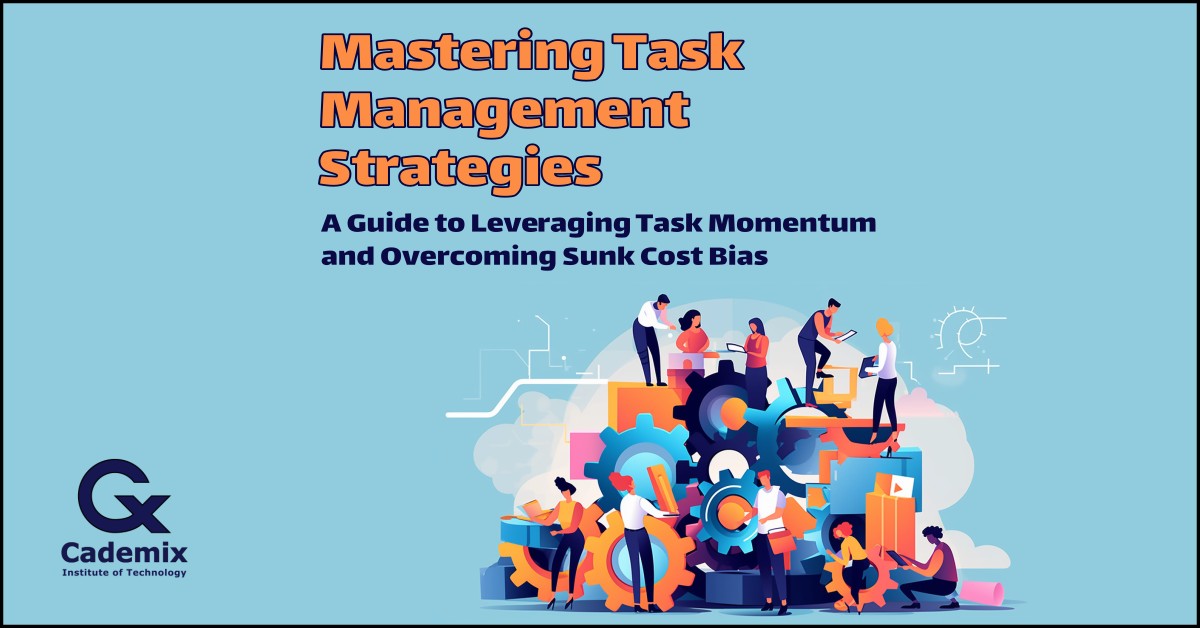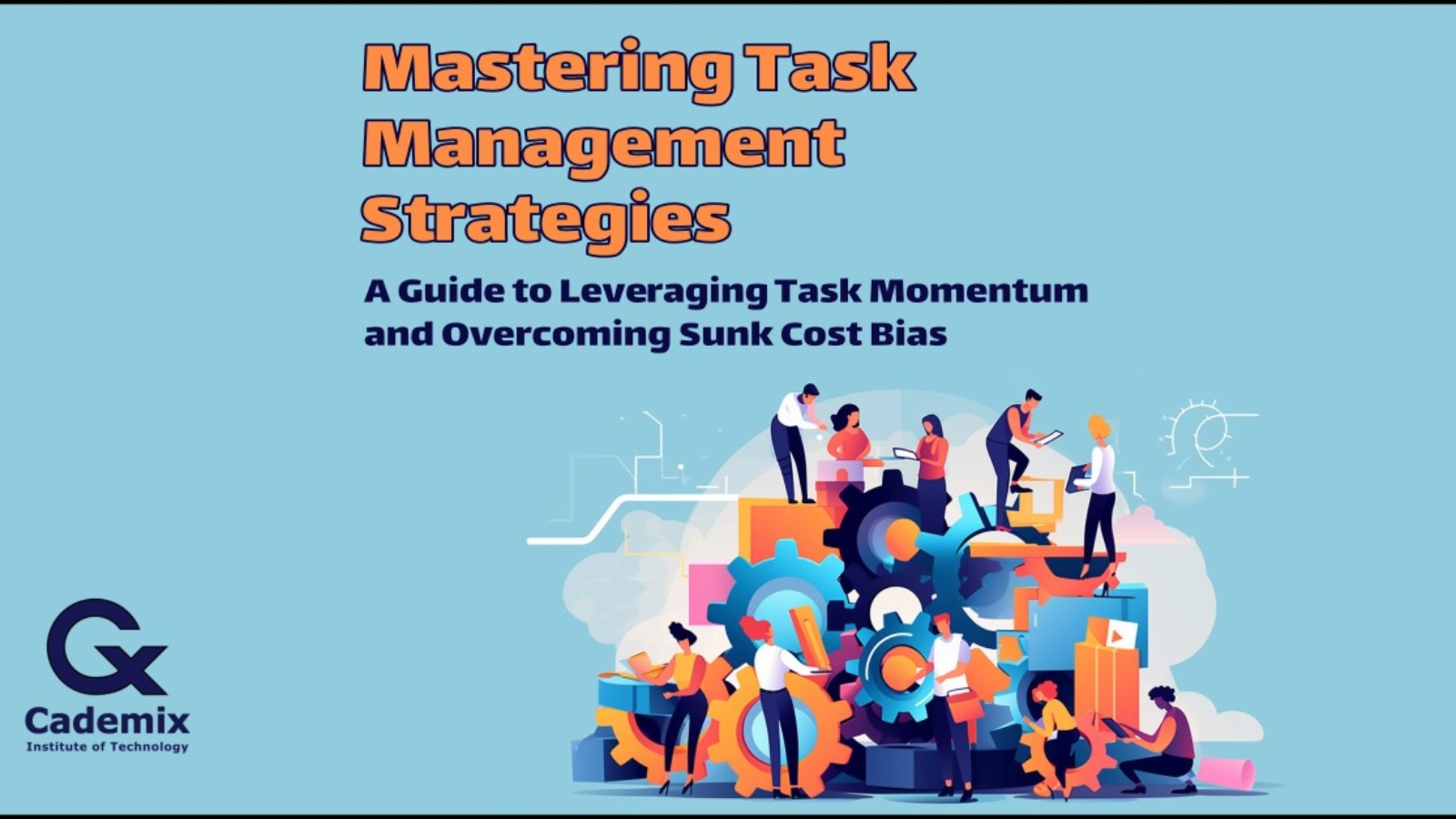Discover effective task management strategies in this easy-to-understand guide, focusing on leveraging Task Momentum and overcoming Sunk Cost Bias. Learn how to strike a balance between prioritizing ongoing tasks and avoiding overcommitment to ensure productivity and efficiency. This article offers practical tips, examples, and insights to help you make better decisions in time and resource management.
“Time management or Task Management is not about doing more things, it’s about doing the right things at the right time.” – Dr. Javad Zarbakhsh

I. Introduction
A. The importance of task management strategies
Effective task management is crucial for success in both personal and professional life. With proper task management strategies, you can stay organized, prioritize tasks, and maximize productivity. This, in turn, helps you achieve your goals more efficiently and reduce stress.
B. What are Task Momentum and Sunk Cost Bias?
In the realm of task management strategies, two important concepts are Task Momentum and Sunk Cost Bias. Understanding these ideas can help you make better decisions when managing your tasks and resources.
Task Momentum refers to the tendency to prioritize and complete tasks that are already in progress. It can be beneficial as it helps maintain focus, avoid switching between tasks too often, and ensure timely completion of tasks.
On the other hand, Sunk Cost Bias, also known as the Sunk Cost Fallacy, is the tendency to continue investing time, effort, or resources into a task based on the amount already invested, rather than its actual importance or relevance to your goals. This can lead to poor decision-making and resource allocation.
In the following sections, we will delve deeper into these concepts and explore how to strike a balance between them for effective task management strategies.
II. Task Momentum: Prioritizing Ongoing Tasks
A. Understanding Task Momentum
Task Momentum is the drive to prioritize and complete tasks that are already in progress. However, it’s important to note that not everyone naturally experiences this momentum. In fact, many people struggle with procrastination, which can hinder task completion.
B. Benefits of Task Momentum
- Increased focus
By maintaining Task Momentum, you can improve your focus and avoid distractions. This is especially important in today’s world, where the rise of new media has significantly reduced attention spans, making it easier to leave tasks incomplete.
- Efficient completion of tasks
When you prioritize ongoing tasks and maintain momentum, you can complete tasks more efficiently. This helps you achieve your goals faster and reduces the chances of leaving tasks unfinished.
C. Tips for leveraging Task Momentum
- Breaking tasks into smaller parts
To overcome procrastination and maintain Task Momentum, break tasks into smaller, manageable parts. This makes them less overwhelming and allows you to focus on each part individually, ultimately making it easier to complete the whole task.
- Setting realistic goals
Setting realistic goals is crucial for maintaining Task Momentum. Unrealistic expectations can lead to frustration and procrastination, which can stall your progress. By setting achievable goals, you can build momentum and work more effectively towards task completion.
Major Take-away of this article:
Are you struggling to finish what you’ve started? Do you find yourself wasting time on things that aren’t important anymore? Then you need to learn about Task Momentum and Sunk Cost Bias. Task Momentum means you give priority to the things you’ve already started, and Sunk Cost Bias means you might be wasting time on things that aren’t worth it anymore. Here are some tips to help you make the most of your time and resources:
- Break down big tasks into smaller parts
- Set achievable goals that are realistic
- Use time blocks to manage your schedule effectively
- Stay organized and keep track of your progress
- Learn to say no to unnecessary tasks
- Stay focused by eliminating distractions
III. Sunk Cost Bias: Recognizing and Overcoming its Pitfalls
A. Defining Sunk Cost Bias
Sunk Cost Bias, or the Sunk Cost Fallacy has also been called the “Concorde fallacy”, occurs when you continue to invest time, effort, or resources into a task based on the amount you’ve already invested, rather than its actual importance or relevance to your goals. This can result in prioritizing tasks that no longer serve you, just because you’ve spent resources on them.
B. Dangers of Sunk Cost Bias
- Misallocation of resources
Falling prey to Sunk Cost Bias can lead to the misallocation of your valuable resources, such as time and energy. By focusing on tasks that are no longer important, you could be neglecting other tasks that could have a more significant impact on your goals.
- Poor decision-making
Sunk Cost Bias can cloud your judgment, causing you to make poor decisions. Instead of evaluating tasks based on their current value, you may prioritize them based on the resources you’ve already invested, leading to suboptimal choices.
C. Strategies for avoiding Sunk Cost Bias
- Periodic task reassessment
To avoid Sunk Cost Bias, regularly reassess your tasks to ensure they still align with your goals. This can help you identify tasks that no longer serve a purpose and adjust your priorities accordingly.
- Knowing when to let go
It’s essential to recognize when a task no longer benefits you and let it go. Abandoning a task can be difficult, especially when you’ve invested resources into it, but doing so can free up your time and energy for more valuable tasks. By letting go of tasks that no longer serve your goals, you can avoid the pitfalls of Sunk Cost Bias and make better decisions.
IV. Striking the Balance: Effective Task Management Strategies
A. Combining Task Momentum and Sunk Cost Bias awareness
To manage tasks effectively, it’s essential to strike a balance between leveraging Task Momentum and avoiding Sunk Cost Bias. By understanding these concepts and their implications, you can make better decisions regarding which tasks to prioritize and when to let go of tasks that no longer serve your goals.
B. Tips for balanced task management
- Regularly reviewing tasks
Consistently reviewing your tasks can help you maintain Task Momentum while avoiding Sunk Cost Bias. Assess your tasks’ progress and relevance to your goals, ensuring that you’re investing your resources wisely and staying on track.
- Aligning tasks with goals
Make sure your tasks align with your overall goals. This helps you maintain focus on what’s truly important, allowing you to prioritize tasks effectively and avoid getting caught up in tasks that no longer serve a purpose.
C. Examples and case studies and Success stories
1. Tom’s focused job search
Tom, a recent graduate, was eager to land his first job. He tried to learn various skills simultaneously but struggled to master any of them. Realizing the importance of depth over breadth, he focused on mastering a few key skills relevant to his field. This allowed him to create a more targeted CV and submit high-quality job applications, ultimately landing him a great job.
2. Anna’s startup adaptability
Anna, a startup owner, recognized that her business wasn’t growing as expected. Instead of sticking with her original plan and sending low-quality proposals to clients, she decided to reassess her strategy. Anna identified the most valuable projects for her business, invested time and effort into completing them, and refined her proposals. This pivot led to increased client interest and business growth.
3. Mike’s industry-responsive CV
Mike, a job seeker, had been using the same CV format for years without much success. He realized that he needed to adapt to the ever-changing industry requirements. By researching current trends and tailoring his CV to match the needs of the companies he was applying to, Mike was able to stand out from the competition and secure multiple job offers.
These success stories highlight the importance of balancing Task Momentum and Sunk Cost Bias awareness for job seekers and startup owners. By adapting to industry requirements, focusing on mastering relevant skills, and prioritizing high-quality projects, these individuals were able to achieve their goals.

VI. The Role of Mentorship in Task Management Strategies
A. Importance of discussing task management with your mentor
Navigating the balance between Task Momentum and Sunk Cost Bias can be challenging. Discussing your task management habits and concerns with a mentor can provide valuable insights, guidance, and support in finding the right balance for you. Mentors can help identify areas where you may be struggling and suggest personalized strategies to improve your productivity.
B. Transparency in mentorship conversations
When discussing task management with your mentor, it’s important to be transparent about your experiences, habits, and challenges. By providing a clear picture of your situation, your mentor can better understand your needs and offer tailored advice.
C. Personality tests and mentorship
Taking a personality test, such as the MBTI, can be a useful tool in understanding your natural tendencies and preferences. Discussing your test results with your mentor can help you both identify strategies that align with your personality type, increasing the likelihood of a successful transition to a more productive workflow.
D. Cademix Acceleration Program
For participants in the Cademix acceleration program, it’s highly recommended to take advantage of mentorship opportunities. Schedule regular sessions with your mentor, ideally within a timeframe of one to three months, to discuss your task management strategies, methods, and techniques. This ongoing support can help you make continuous improvements in your productivity and achieve your goals more effectively.
VI. Conclusion
In conclusion, effective task management strategies play a crucial role in achieving success, whether you are a job seeker, a startup owner, or someone simply looking to improve their productivity. By understanding and leveraging Task Momentum, you can prioritize ongoing tasks and maintain focus on what’s important. However, it’s essential to remain aware of the pitfalls of Sunk Cost Bias, which can lead to the misallocation of resources and poor decision-making.
Striking a balance between Task Momentum and Sunk Cost Bias is key to efficient time and resource management. Regularly reviewing tasks, aligning them with your goals, and being adaptable to industry requirements are vital strategies for achieving this balance. By implementing these principles, you can maximize your potential and reach your objectives more effectively.

